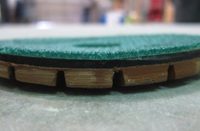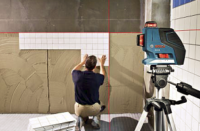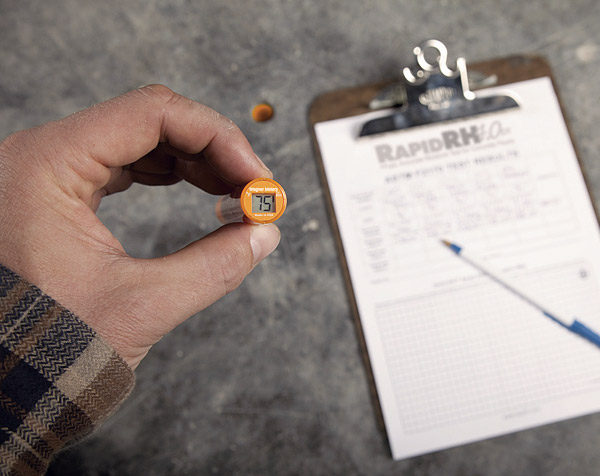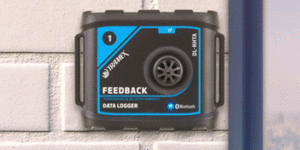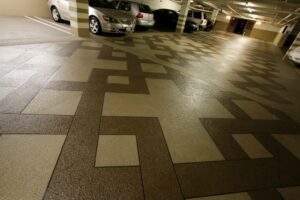Beauty and strength converge in decorative concrete. They fuse to create a durable, pleasing floor that literally becomes the foundation of a room’s space and atmosphere. Achieving the desired result requires that you consider a number of variables for the specific stain and sealer combination you select.
One of the most important variables that require your attention is the moisture content in the concrete at the time the stain and sealer are applied. Moisture in concrete can come from two main sources. The first is the volume of water used to mix the concrete. Second, external sources of water may be an issue, such as water that can migrate from the ground to the concrete slab in the absence of a vapor retarder.
Both evaporating water and pooled water can interfere with a stain or sealer.
Right finish, wrong time
The damage that excess moisture can do to your stain or sealer can look different depending on the amount of excess moisture and the type of stain or sealer used. Here are some common indicators that the stain or sealer was applied too soon — before the concrete had a chance to dry sufficiently.
Efflorescence: As the concrete dries and its moisture rises upwards through the slab, it carries salts within the concrete to the surface with it. When too much moisture is moving through the concrete, it leaves a salt residue called efflorescence. As lovely as the word sounds, efflorescence is rather unsightly. Depending on whether or not the floor has been finished, efflorescence manifests in different ways. It can leave a white powdery substance on the concrete’s surface after staining but before sealing. If the efflorescence gets trapped underneath a sealer or certain stains, it will look like a white “blush” has been spread on the concrete. Efflorescence can cause other stain or sealer failures, too. Read on.
Effects on stains
Reactive and nonreactive stains color the concrete in different ways, leading to different indications of moisture damage. In the case of reactive stains, the problems generally have to do with color variations.
Undesirable color changes: The acid in reactive stains contains metallic salts that instigate a chemical reaction when they mix with the free lime in the concrete. This reaction provides the stain color, but when excess moisture exists, the salts or acids in some blue and green stains can turn brown or black. The exact cause isn’t clear, but the most popular explanations attribute the undesired color change either to oxidation or a fungus, both of which can happen with excess moisture.
Lighter or uneven coloring: Efflorescing salts in the presence of excess moisture will retard stain penetration, interfering with the chemical process of the acid stain coloring the concrete. Use of nonreactive stains in the presence of excess moisture gives rise to a different set of issues. Since a nonreactive stain colors the concrete by filling the concrete’s pores or by creating a film that sits on the concrete’s surface, typical moisture-related problems include flaking, peeling, bubbling, blistering and dark spots.
Flaking and peeling: An indication that the stain failed to bond with the concrete due to excessive moisture.
Bubbling or blistering: Caused by moisture that can’t escape.
Dark spots: A sign of trapped moisture that can’t evaporate.
Water-based sealer issues
Excess moisture can create several different problems when it comes to using sealers. For example, the following may occur when using a water-based sealer.
Powdery or white substance: The drying process for a water-based acrylic sealer can be drastically altered by the temperature and humidity of the drying environment. If the temperature is low or humidity is high during the drying process, the coalescing solvent in the sealer will evaporate before the water, leaving the latex particles “unbound.” Thus, the powdery or white appearance.
Solvent-based sealer problems
The following may occur when solvent-based sealers are applied in the presence of excess moisture.
Grayish or cloudy spots: Moisture can lift the sealer away from the concrete, which causes light to diffuse underneath the sealer (also called “sealer diffusion”), resulting in the appearance of discoloration.
Color whitens or “blushes”: Too much moisture on the surface prevented the sealer from bonding, so it floats on the moisture instead.
Cracking, chipping, peeling or flaking: Another consequence of high pressure caused by moisture vapor that can’t escape.
Frothy foam: The resin in a two-part solvent sealer bubbles when mixed with too much water, leaving a foamy substance.
As the concrete dries, moisture evaporates. Since a vapor retarder is typically placed underneath interior concrete slab installations, all of the moisture must evaporate by traveling upwards through the slab. Furthermore, if the relative humidities in the concrete and the air around it are different, the concrete will either give off or absorb moisture. The volume of water to be evaporated and the rate at which it evaporates impact when the concrete is ready to take a stain or sealer.
The many moisture-related problems described above can be avoided if the stain and sealer are applied when the moisture content within the concrete slab reaches an acceptable range — one that takes into account the specific moisture tolerance for the planned finishes. By waiting until the concrete has dried sufficiently, you won’t be trapping excess moisture when applying the stain and sealer.
How to test for moisture
Conducting a moisture test beforehand is the only way to determine if the concrete is ready to be finished. One commonly used moisture test in the United States is the calcium chloride test. This test relies on a a salt compound placed on the concrete’s surface to gauge whether excess moisture remains. The problem with this test is that it only measures moisture at the surface. Because a moisture gradient (drier at the top, wetter at the bottom) exists within the concrete slab as it dries, the calcium chloride test does not provide an accurate representation of the true moisture condition deeper within the slab, nor does this test indicate the moisture that will later be seen at the surface as the slab moves toward a moisture equilibrium.
A more inclusive test for evaluating the true moisture condition of the concrete is in-situ relative humidity (RH) testing. This test has been used for some time in Europe, and is growing in popularity in the United States due to the scientific evidence supporting its accuracy.
When RH probes are placed at 40 percent depth within the slab (the correct depth for placement when the slab is drying from the top only), it has been demonstrated that the test results provide an accurate representation of the moisture level in the slab after it is sealed. While it is critical to get an accurate measure of the moisture level of a concrete slab, it is equally critical to know the moisture content readings that will be considered acceptable for applying the finish for your specific project.
The results of the RH moisture test must be evaluated against the moisture tolerance specified by the manufacturer for that exact stain or sealer. Pay particular attention to how permeable or “breathable” the finish is. For example, epoxies are the least permeable, which means moisture trying to escape an epoxy-coated slab will be unable to do so, and if moisture levels are in excess of the manufacturer’s recommendations, these coatings are the most likely to be damaged.
Besides the recommendations of the manufacturers of the stain and sealer, certain other factors that may be unique to your project should also be taken into account. Here are some crucial variables to consider when determining the acceptable relative humidity range for your flooring finishes:
- Age and thickness of the concrete
- Grade of the slab
- Any materials being used to prepare the concrete and the water contents of each
- Ambient drying conditions
- Time available for the concrete to dry, including the time to dry between stain and sealer application.
Waiting to apply the stain and sealer until the concrete is ready takes planning and patience. However, the little bit of extra effort is more than worth it. You will avoid significant problems and achieve the result you seek: high-quality decorative concrete that offers exceptional longevity and beauty.

